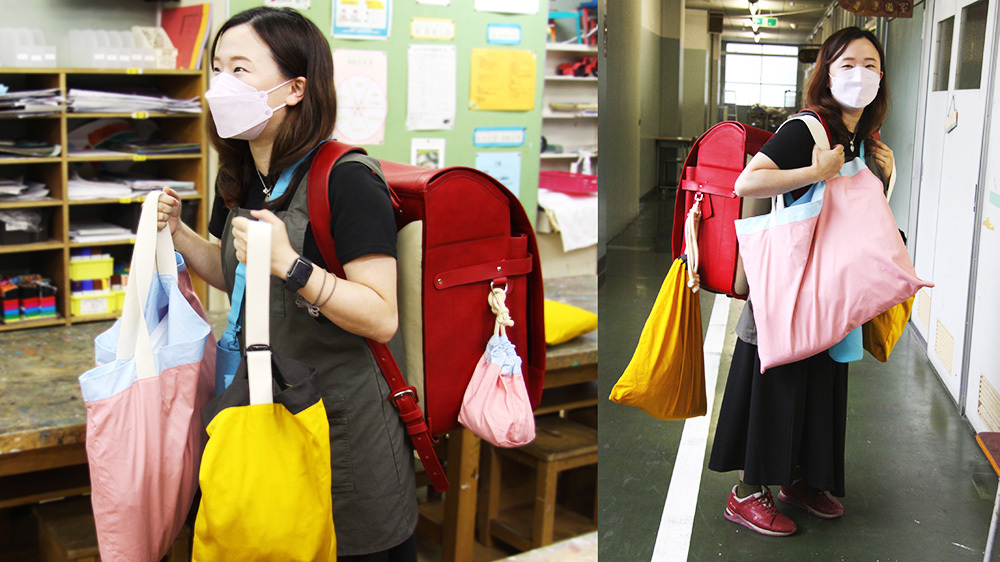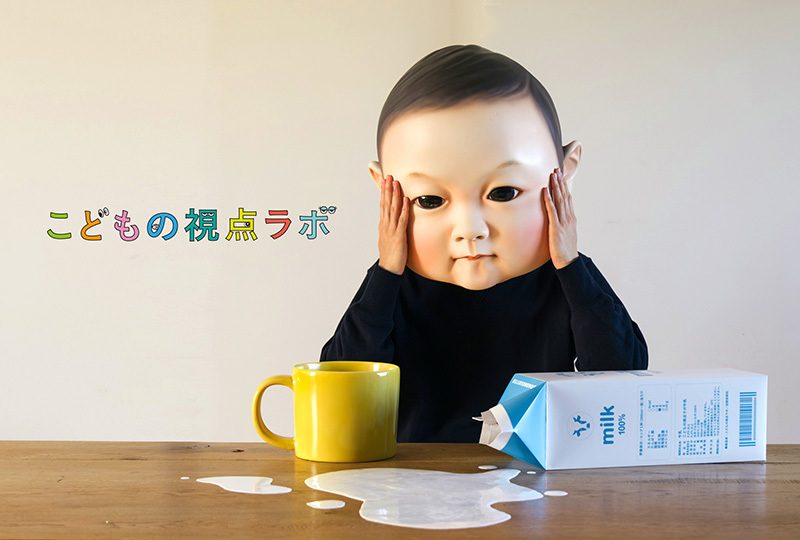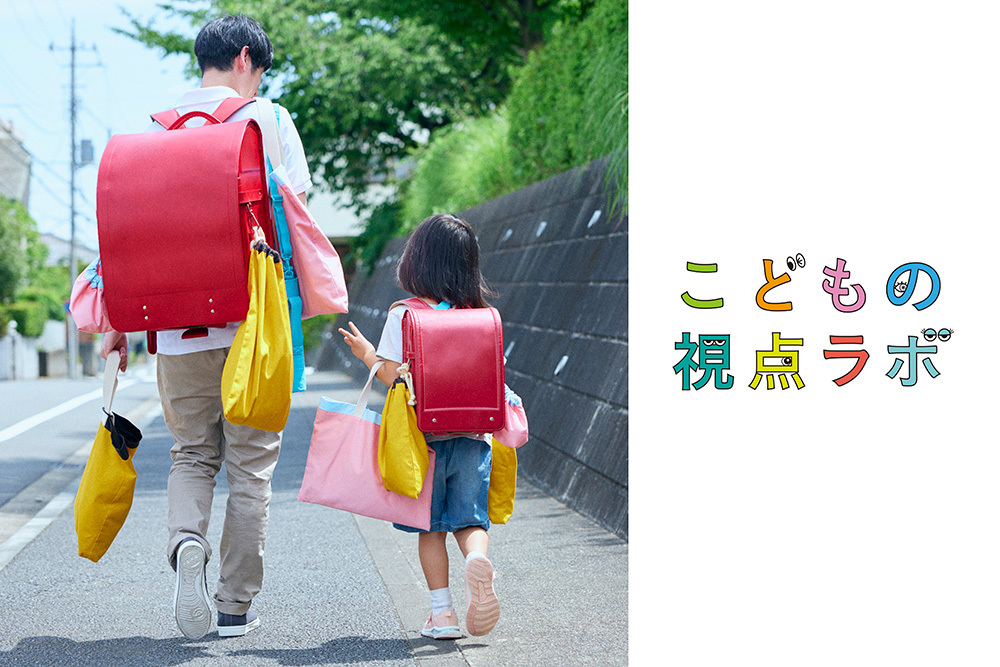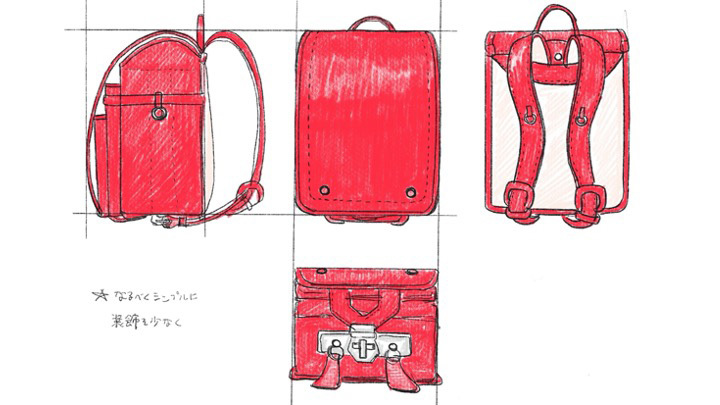The Children's Perspective Lab conducts activities to deepen understanding of children by having adults experience childhood. While our research has primarily focused on infants and toddlers until now, a theme suddenly emerged when my son entered elementary school: the school backpack. We knew the weight was an issue, but it's truly heavy. Is it really okay for petite first-graders to carry such a heavy load every day?? That's the level of concern. We decided the only way to know was to experience it firsthand, so we commissioned a workshop that actually makes randoseru to create one for us.
A child's randoseru feels like about 19kg to an adult!?
I drew a design sketch of an average randoseru and had it made using the same synthetic leather material used in actual randoseru. The size and weight were calculated based on the idea of an adult man becoming a first-grade girl and trying to carry it. Using the average weight of an elementary school student's bag (5.7kg※1) as a base, the calculated weight was a staggering 18.9kg! Seriously, just seeing the number makes it feel way too heavy.

※1
Based on research by Professor Ken Shirotsuchi, Taisho University / 2017, average weight of school bags for all 91 first- to sixth-grade students in Tokyo (including sub-bags). Calculated size and weight by substituting the national average height & weight for first-grade girls (age 6) (Source: School Health Statistics, 2020) with a 180cm tall, 70kg male.
Furthermore, I'll re-list the items my own child carried on Monday mornings during their first-grade year. Since the backpack couldn't hold everything, I decided to make adult-sized versions for the indoor shoe bag, gym clothes bag, lunch bag, art supplies bag, and water bottle that had to be carried by hand. Some days, a music bag, library bag, or lunch duty apron bag were added. Before long breaks, they'd bring home their art supply box, disaster hood, art projects, and even morning glory pots. Oh, it's just too much!!

Here's a list of my child's belongings during their first year of elementary school.
We had teachers and board of education staff try on
The finished adult randoseru & sub-bag (total 18.9kg). This time, we really wanted educators to actually try carrying it! So, Fumiko Ishida and Mitsuhiro Kutsukake from Kodomo no Shiten Lab headed to Koganei Municipal Minami Elementary School, where Ms. Masako Takahashi kindly agreed to the experience.
Ishida: Ms. Takahashi, this is the adult-sized schoolbag.
Ms. Takahashi: Oh, it's huge.
Kutsukake: It's very heavy, so we'll support it while you put it on. Ready? I'm letting go now?
Ms. Takahashi: Whoa, it's this heavy? It's like something a mountaineer would use to deliver supplies to a mountain hut. If I don't lean forward, it pulls me backward. I'll... I'll just step out into the hallway a bit.
Bravely walking up and down the hallway multiple times, Takahashi-sensei declared, "I'll try climbing stairs too!" experiencing it in a way close to the children's daily routines. His figure began to resemble that of a determined first-grade girl.
Mr. Takahashi: Ah, sweat... Walking for just 10 minutes is tough. But some kids in this district walk 30 minutes, right? Some have hills too. And it's not just walking—they have to take off their shoes, put on indoor shoes, climb stairs while carrying this...
Kutsukake: Yes. We were surprised by the weight when we actually made it ourselves.

"It's considerably heavier than I imagined," says Ms. Masako Takahashi of Koganei Municipal Minami Elementary School.
Ms. Takahashi: I thought I understood, but experiencing it is different. I felt the power of having it recreated as a physical object. I only walked while carrying it, but the children perform actions beyond just carrying it every day. It really drove home how much of a burden they carry through their school lives.
Ishida: How do you think we should approach this problem?
Ms. Takahashi: It's a difficult problem, isn't it? I don't think it can be solved simply by "reducing the load." I believe it involves complex factors, like balancing it with learning.
Kutsukake: Complex factors?
Professor Takahashi: Take tools, for example. In my art classes, lower grades use the most basic, bulky types. Things like large "pot glue," scissors with cases, and reusable but heavy oil clay. As students advance, we can switch to stick glue, paper clay, or mechanical pencils to reduce weight. But for younger grades, learning the basic functions and usage of these tools often means starting with larger, fundamental items.
Ishida: Writing tools are also specified, like "five B pencils and one red pencil," right?
Takahashi: I think that's the right amount and type of tools developmentally, to get used to the act of "writing characters" – like the basic pencil grip and pressure. Lower grades still find it hard to sort their belongings themselves.
Kutsukake: It's true you can't just give them one pencil right away. But it struck me that tools tend to be largest when children are smallest. Yet the tools adults use keep getting lighter and more compact.
Ishida: Textbooks have also gotten larger, like A4 size, compared to the past. While they include more visuals and other enhancements to aid understanding, that means more pages and increased weight.
Professor Takahashi: That's right. Also, as children advance to higher grades, they learn to choose what they need themselves, but that's impossible for a child just starting school.
Ishida: Absolutely! My son brought home every single textbook during his first year. Just recently, at a parent meeting, I asked, "Isn't bringing everything home a bit much?" The teacher explained, "Textbooks not needed for homework can be left behind. Each student has a designated space for storing books." It turned out my son simply didn't understand and was bringing everything home regardless.
Takahashi: So there was a misunderstanding. Schools appreciate feedback from parents, and it's great when we can communicate carefully to find the best way for that school to reduce the children's burden. Instead of having students carry everything personally, increasing shared items at school might be one solution.
Ishida: Just complaining that "it's too heavy!" won't solve the problem. It's important for parents to also propose ideas to the school, like "What about doing it this way?" and show a cooperative attitude. Thank you, Teacher.
Next, we wanted the Board of Education to take on this challenge! So, we cautiously approached the Education Policy Promotion Division of the Yokohama City Board of Education. Yasuhide Kawase, the supervising principal, responded enthusiastically: "That's fascinating! Since it's about schoolbags, it's best for staff with elementary school experience to try them. We have two such staff members here, but I'll reach out to other divisions too." With his approval, we arranged for five supervising principals with elementary school experience to gather. Off to Yokohama City Hall we went!
Ishida: This is the adult-sized randoseru.
(The Board of Education members murmured in surprise at its size)
Kutsukake: It's quite heavy, so please stand up slowly after putting it on.
"What? Seriously? It's this heavy?" "It feels like it's pulling me backward." "It's like a real mountain hike." "Running with something this heavy... no way." "Everyone should try this! Let's get other staff members too!"
One after another, those who tried it spoke up, and in the end, about 15 staff members carried it. When we spoke with them again,

The staff from the Yokohama City Board of Education took turns carrying it.
"It was far heavier than I imagined. Some children must carry this much weight up hills every day," "Junior high school backpacks are also quite heavy, so I became concerned about that too," "It made me realize we must truly stand in the children's shoes and support them. Experiencing this firsthand was invaluable," "We must continue working to reduce the weight of these bags. Thank you for this valuable experience." They even offered words of gratitude. Thank you so much!
Professor Ken Shiroto, who is researching excessively heavy school backpacks—will this problem be solved?
Now, as discussed with Mr. Takahashi on-site and members of the Yokohama Board of Education, the topic of notebook PCs and tablets came up. Currently, their weight seems to be heavily bearing down on children's backs. So, we asked Professor Ken Shiroto of Taisho University, who has long investigated the "excessively heavy schoolbag problem," about recent trends in schoolbag weight and the outlook for the future.
Ishida: Professor Shiroto, we based our adult-sized schoolbag design on your 2017 data showing an "average weight of 5.7kg." But back then, kids hadn't started bringing laptops yet, right? Could it be that bags are heavier now than they were then?
Professor Shiroto: That's right. Actually, after that survey, in 2018, the government issued a notice allowing students to leave their schoolbags at school ("okiben"). Schools started implementing measures, and I had the impression the load was decreasing. However, then COVID-19 hit, and the use of notebook PCs and tablets for home learning rapidly accelerated. More schools also started requiring students to bring water bottles, so the load has gotten heavier again.
Ishida: Yeah, really. Among the parents I know, tablets and water bottles are called the "last big items." They feel like the two giants.
Kutsukake: But what is the appropriate amount of luggage for children in the first place?
Professor Shiroto: American research suggests the ideal backpack weight should be 10% of body weight. (※2) So for a 25kg child, that's 2.5kg. Clearly, it's too heavy now. My own survey found some children carrying over 11kg! (※3)
※2
Association of relative backpack weight with reported pain, pain sites, medical utilization, and lost school time in children and adolescents/by Michael J Moore , Gregory L White, Donna L Moore /2007 May/National library of medicine
※3
Based on research findings by Professor Ken Shirotsuchi, Taisho University. Conducted over two weeks in April 2018 with 58 elementary school students in the Tokyo metropolitan area. Includes the weight of sub-bags.
Ishida: 11kg! That's over 30kg for an adult backpack!
Kutsukake: That's impossible to carry...
Professor Shiroto: When I talk to people from countries where school buses or parental drop-offs are the norm, they say, "I can't believe you make children carry such heavy loads every day!" It might also relate to Japan's deep-rooted mindset that values diligence, effort, and endurance as virtues.
Ishida: Some parents might say, "Don't be lazy, work harder." But when you experience it yourself, you clearly understand that complaining about the weight isn't laziness at all.
Professor Shiroto: Heavy school bags can cause chronic shoulder stiffness and back pain. When this "physical discomfort" overlaps with the "mental discomfort" of disliking going to school (commuting blues), it leads to what's known as the school bag syndrome (※4). It's completely backwards that school life, which should be enjoyable, becomes depressing because of the bag.
※4
A condition where carrying a schoolbag that is too heavy or too large for one's body causes physical and mental discomfort.
Kutsukake: That's exactly right. Teacher, do you think this problem will improve in the future?
Professor Shirotsuchi: Well, while PCs have become widespread, textbooks and paper homework haven't decreased yet. I think we're currently in a "transitional phase" for school supplies. If the digitization of learning content catches up, the amount of supplies should decrease. So, I do see a faint glimmer of hope for a solution. I also hope that the effective spread of ICT education will brighten the future for our children.

Holding an old randoseru, Professor Ken Shirakudo notes, "Randoseru themselves have also become larger nowadays."
Digitizing learning content seems like a potential solution to alleviate this problem, but it will likely take a little more time. Let's summarize what we've learned.
●Converting the weight of a randoseru to adult terms reveals it equates to a staggering 18.9kg. (※1)
●American research indicates that the ideal weight for a child to carry should be 10% of their body weight. It's important to recognize that Japanese elementary school students carry loads far exceeding this. (※2)
● The heavy randoseru causes "physical discomfort" like chronic shoulder stiffness and back pain, and "mental discomfort" like developing a dislike for going to school (commuting blues), leading to randoseru syndrome. We shouldn't dismiss this as just a bag problem.
Imagine if adults were required to commute carrying a 42-pound (approx. 19kg) load every day. Wouldn't they demand improvements from their unions or companies? It's hard to believe they'd just accept it as "the rules" and commute like that. Thinking about children struggling to walk to school with such small bodies, I feel adults need to ask themselves, "What if it were me?" and truly consider things from the children's perspective.

Reading this helps you understand "a child's perspective"!

















